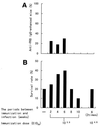Protection against influenza virus infection of mice fed Bifidobacterium breve YIT4064
- PMID: 10066652
- PMCID: PMC95685
- DOI: 10.1128/CDLI.6.2.186-192.1999
Protection against influenza virus infection of mice fed Bifidobacterium breve YIT4064
Abstract
Mice fed Bifidobacterium breve YIT4064 and immunized orally with influenza virus were more strongly protected against influenza virus infection of the lower respiratory tract than ones immunized with influenza virus only. The number of mice with enhanced anti-influenza virus immunoglobulin G (IgG) in serum upon oral administration of B. breve YIT4064 and oral immunization with influenza virus was significantly greater than that upon oral immunization with influenza virus only. These findings demonstrated that the oral administration of B. breve YIT4064 increased anti-influenza virus IgG antibodies in serum and protected against influenza virus infection. The oral administration of B. breve YIT4064 may enhance antigen-specific IgG against various pathogenic antigens taken orally and induce protection against various virus infections.
Figures

 , inoculation with PR8;
, inoculation with PR8;
 , collection of sera;
-➤, observation.
, collection of sera;
-➤, observation.



 and
and
 ,
P < 0.02 and P < 0.05, respectively,
versus accumulated symptom rate in groups 9 and 7, respectively, by
Fisher’s exact test.
,
P < 0.02 and P < 0.05, respectively,
versus accumulated symptom rate in groups 9 and 7, respectively, by
Fisher’s exact test.
 ,
P < 0.05 versus survival rate in group 7 or 9, by
Fisher’s exact test.
,
P < 0.05 versus survival rate in group 7 or 9, by
Fisher’s exact test.
References
-
- Balkovic E S, Six H R. Pulmonary and serum isotypic antibody response of mice to live and inactivated influenza virus. Am Rev Respir Dis. 1986;134:6–11. - PubMed
-
- Chen K S, Quinnan G V. Induction, persistence and strain specificity of haemagglutinin-specific secretory antibodies in lungs of mice after intragastric administration of inactivated influenza virus vaccines. J Gen Virol. 1988;69:2779–2784. - PubMed
-
- Couch R B, Kasal J A. Immunity to influenza in man. Annu Rev Microbiol. 1983;37:529–549. - PubMed
MeSH terms
Substances
LinkOut - more resources
Full Text Sources
Other Literature Sources

